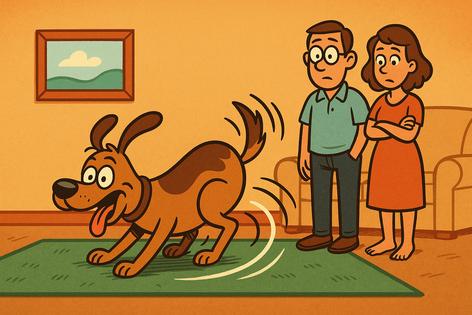What to do when your dog does the booty scoot
Published in Cats & Dogs News
When a dog suddenly scoots its rear end across the floor, many pet owners respond with laughter, confusion, or mild horror—especially if it’s happening on a freshly cleaned carpet. The behavior, commonly referred to as “boot scooting,” may look comical, but it often signals that something is bothering the dog’s backside. While an occasional scoot might not be cause for concern, repeated or frantic dragging could indicate an underlying health issue that deserves attention.
Scooting is typically a dog’s response to discomfort or itching in the anal area. Unlike humans, dogs cannot scratch this sensitive spot with their paws or reach it easily with their mouths. Instead, they attempt to relieve the sensation by dragging their bottom across a surface—usually carpet, grass, or tile. This instinctive behavior can be triggered by a number of causes, the most common being impacted or infected anal glands.
Anal glands, or anal sacs, are two small, pea-sized structures located just inside a dog’s rectum. They contain a foul-smelling fluid that is naturally expressed when a dog defecates. This fluid carries unique scent markers that dogs use for identification. Occasionally, however, the ducts of these glands can become blocked, causing the sacs to fill with fluid. This leads to pressure, swelling, and discomfort, which the dog attempts to alleviate by scooting.
Impacted anal glands are most frequently seen in small breeds such as Chihuahuas, Lhasa Apsos, and Dachshunds, though dogs of all sizes can be affected. Left untreated, the glands may become infected and even abscess, sometimes rupturing through the skin near the anus. In such cases, owners might notice blood or pus near the dog’s hindquarters or see the dog licking obsessively at the area.
Aside from anal gland issues, other causes of scooting include intestinal parasites like tapeworms, which irritate the anal region as segments of the worm are shed through the rectum. Food allergies, particularly to ingredients like beef, dairy, or wheat, can cause inflammation or itchiness that prompts scooting. Skin infections, injuries, and even matted fur around the anus can also lead to discomfort that a dog tries to ease through dragging.
Veterinarians advise that the first step in addressing scooting is to observe the frequency and intensity. An occasional scoot after defecation might be nothing more than an itch or debris stuck in the fur. However, repeated episodes, signs of pain, or visible swelling should prompt a visit to the vet. During the examination, the veterinarian will likely check the anal glands for signs of impaction or infection and may manually express them if needed.
In some cases, dogs require regular manual expression of their anal glands, particularly if they have chronic issues or do not express the fluid naturally through bowel movements. This procedure, though unpleasant, is generally quick and provides immediate relief. Some owners learn to perform it at home, though most prefer to leave it to professionals due to the smell and technique involved.
Diet can also play a significant role in preventing scooting caused by anal gland problems. A high-fiber diet helps firm up a dog’s stools, increasing pressure on the anal glands during defecation and promoting natural expression. Many commercial dog foods now offer high-fiber formulas specifically designed for digestive and glandular health. Adding fiber-rich vegetables like pumpkin or green beans to a dog’s meals can also help.
Parasite prevention is another key component in reducing scooting. Regular deworming, based on a veterinarian’s recommendations, protects dogs from intestinal parasites that might cause itching or inflammation. Flea control is equally important, as fleas can transmit tapeworms. Good hygiene, such as keeping the dog’s rear end clean and trimming long fur around the anus, also helps minimize irritation.
Behavioral factors can’t be ruled out entirely. Some dogs may scoot out of habit or as a way to get attention. If medical causes have been ruled out, pet owners might consider whether their reaction to the behavior—laughing, scolding, or giving treats afterward—could be reinforcing it. In such cases, ignoring the behavior and redirecting the dog’s attention might help reduce its frequency.
For dogs with persistent anal gland issues that don’t respond to dietary changes or regular expression, more aggressive treatments may be necessary. Some veterinarians recommend a procedure to flush the glands or even surgically remove them in severe cases. However, removal is generally a last resort, as it carries the risk of nerve damage and fecal incontinence.
It’s also important to consider age-related changes. Senior dogs may be more prone to constipation or decreased muscle tone, both of which can affect natural gland expression and lead to increased scooting. Keeping older dogs active, hydrated, and on a vet-approved diet is essential in maintaining their anal health.
Though boot scooting may seem like a minor nuisance or a source of comic relief, it often reflects a dog’s attempt to communicate discomfort. Understanding the causes and knowing when to seek veterinary help is crucial to preventing more serious problems. By maintaining good hygiene, providing a healthy diet, and scheduling regular checkups, pet owners can help ensure that their dog’s scooting days are kept to a minimum.
In the end, dogs rely on their people to notice changes in behavior and act accordingly. A single scoot may not be a crisis, but repeated rear-end dragging deserves a closer look. While it may never be the most glamorous part of pet ownership, caring for a dog’s behind is just another way to show love—and to keep that new carpet looking its best.
========
This article was created, in part, using AI tools









Comments